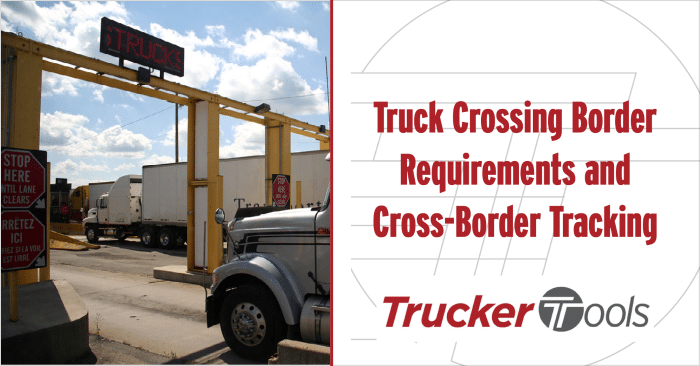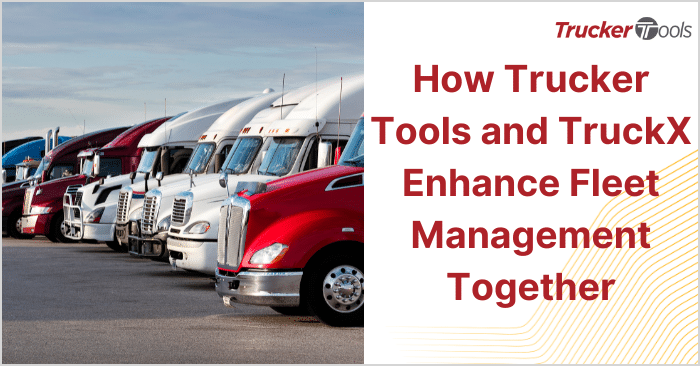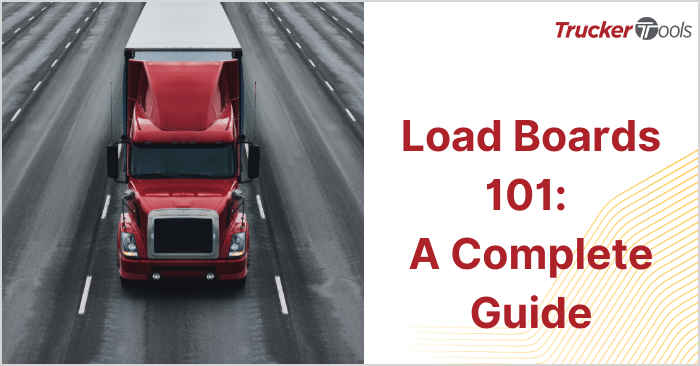If you work as a driver or freight broker or are the owner of a brokerage or trucking business, you’ve likely heard about the increasing popularity of moving freight across borders via commercial trucks. In reaction to the supply chain problems experienced during the height of the COVID-19 pandemic, many U.S. companies are shifting their supply chain strategies to embrace nearshoring. This change in approach has driven increased trade between U.S. companies and Canadian and Mexican companies. As a result, the number of trucks crossing both borders has increased significantly over the last 24 months. Check out these three things you should know about truck crossing border requirements and cross-border tracking.
#1. Truck Crossing Border Requirements: Canada
In terms of truck crossing border requirements for commercial trucks entering Canada from the United States, truckers are required to present a valid passport, Social Security card, a commercial driver’s license (CDL) and in some cases a FAST membership card. FAST stands for Free and Secure Trade Program. FAST is a joint program between the Canada Border Services Agency (CBSA) and United States Customers and Border Protection that is meant to reduce delays and simplify commercial shipments. Though applying for FAST isn’t mandatory, it does speed up border crossings to/from Canada and the United States. FAST lanes are available at Sarnia, Ontario/Port Huron, Mich., Pacific Highway, British Columbia/Blaine, Wash., Fort Erie, Ontario, Emerson, Manitoba, and Windsor, Ontario/Detroit.
Before shipping or hauling goods by commercial trucks into Canada, carriers also must apply for a CBSA carrier code, a four-character identifier that will be used when crossing the border. To apply for a carrier code, carriers need to determine whether a non-bonded or bonded carrier code is required. In most cases, a carrier’s existing cargo and liability insurance will cover crossing the Canadian border. Keep in mind that the minimum for general freight liability coverage for carriers must be $1 million and that cargo coverage requirements may vary according to gross vehicle weight.
#2. Truck Crossing Border Requirements: Mexico
Nearly 35,000 commercial trucks cross the U.S.-Mexican border on a daily basis, making Mexico the United States’ new number one trade partner. (Before 2023, Canada ranked as the United States’ top trade partner.)
In terms of truck crossing border requirements for trucks entering Mexico from the United States, truckers must bring with them a letter of instructions and the bill of lading signed by the buyer and carrier with details about the goods sold, place of origin and other details about the shipment. Other documents needed for a truck crossing the border are a commercial invoice (in Spanish), sales contract, customs declaration, proof of insurance, AES filing (used for collecting export trade data), USMCA Certificate of Origin (if applicable), proforma of commercial invoice and a packing list that details the contents, weight and type of shipment. The driver/carrier also will need the recipient’s company name, full address, phone number, tax ID/RFC number, contact name, contact email address and delivery number.
Before the shipment arrives at the Mexico border, you’ll want to ensure that the cargo being transported is legal to be transported in Mexico. Some medications, second-hand clothing and specific types of fish are illegal to transport in Mexico. Also, keep in mind that cargo inspections at the Mexico border by custom officials may be lengthy and impact estimated arrival times. Mexican border officials also may ask for proof that the commercial truck crossing the border is in good mechanical shape, so be sure that the truck transporting the load has been inspected and the inspection documented.
#3. Truck Crossing Border Tracking
When evaluating a freight tracking software for trucks crossing borders, you’ll want to prioritize those solutions that support international phone numbers and addresses. You also should look for cross border tracking technology that can use used with WhatsApp, a popular international texting and talking app. When you have a truck crossing a border, multi-language support is a must-have, as well, especially support in Spanish and French. Most cross border tracks involve three or more commercial trucks, which is why any cross border freight tracking solution you consider ought to support multiple driver phone numbers and truck/trailer numbers on each track. Multi-driver load tracks also come in handy for team loads. You’ll want a load tracking technology that includes ELD integration options for drivers, too, to drive high carrier compliance.
Learn more about “The Evolution of Cross-Border Freight Tracking.”
Watch our webinar “How To Eliminate Fraud for Freight Brokers” on demand.






